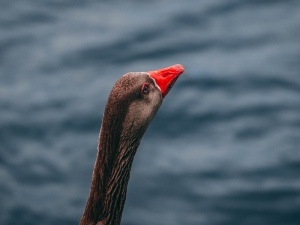
A duck’s bill isn’t made up of keratin alone, these beaks actually have a layer of skin around them. This skin is an organ that lives just as the bird’s other organs do.
If you notice that your duck’s bill is peeling you’d be right to be concerned, this article looks into why this happens.
Table of Contents
Ducks beak is peeling:
A change in your duck’s appearance or behavior is a sign of a change in your bird, this includes a duck’s bill peeling. Here are reasons why this may be happening:
Normal peeling:
Human skill cells shed all the time, this process keeps the skin from looking dull. The skin on a duck’s bill will shed its old cells just as human skin does, this may sometimes look like light flaking but it may also look like peeling in some cases.
While this peeling doesn’t seem to happen on a schedule, the skin does peel at certain times of the year. This peeling is especially common in drakes.
The peeling usually happens around the bird’s nostrils and can look quite startling. The color of your bird’s bill may change at this time, the skin may go from yellow to orange or even green.
What to do:
The peeling of skin on your bird’s bill is actually quite a normal and common phenomenon, there isn’t anything you need to worry about if this is what’s going on with your bird.
Just to make sure, keep an eye on the bird to make sure that it doesn’t start showing signs of distress. Signs of the bird being in distress include self-isolation, refusing to eat or drink, being very quiet, and laying or sitting down with its eyes closed.
If the bird does start to show these symptoms then you’d need to quickly get the bird to the vet. Ducks only show signs of being ill or injured when they are very far gone, they will need a vet at this point
Infection:
Another reason why your duck’s beak may start to peel is if the outer layer of the bird’s beak has a bacterial or fungal infection. Flaking as a result of infection will look more extreme than it would if the bird’s beak was simply routinely peeling.
What to do:
You can treat the bird’s infection at home. There are various treatment options for this condition, many of which do not need a prescription.
Treatment options for this condition include antibiotic creams, antifungal creams, colical silver, which is a natural antibiotic, manuka honey cream, which is antibacterial, Neosporin cream as well as 1% silvadene cream. You would need to get a prescription to get the 1% silvadene cream.
Apply these treatments onto the bird’s beak on a daily basis until the flaking has completely stopped.
If you’re using the product, but the bird’s peeling doesn’t seem to be getting better, then you’d need to take the bird to the vet for an examination and a diagnosis.
FAQ’S
Can duck beaks heal?
Duck beaks can heal in some cases but not all.
Wheather a ducks beak will heal or not will depend on how deep the beak break is. If the break is minor, and if only ⅓ of the beak is broken, then the beak will grow new keratin and heal.
If the break is deeper than ⅓ of the way in then the tissue may be damaged and may not be able to grow new keratin and repair the beak.
If the beak is too short to heal then you can consider getting a beak prosthetic for the bird or allowing the bird to get used to living with a broken beak.
How do you treat a cracked beak?
If the break if minor then you can leave the beak alone and it will heal on its own.
If the beak break is major then you may need to take the animal to a rehabilitation center where the professionals will stabilize the beak and splint the beak
If you enjoyed this article then you may also be interested in other chicken related articles. Here are some articles that you may be interested in: Do Duck Bills Shed, Duck Suddenly Can’t Walk, How Can You Tell If A Duck Is In Pain

